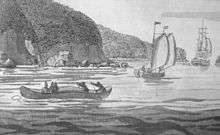R v Marshall
| Indigenous peoples in Canada |
|---|
|
History
|
|
Culture
|
|
Demographics
|
|
Religions |
|
Index
|
|
Wikiprojects Portal
WikiProject
First Nations Inuit Métis |
R v Marshall (No 1) [1999] 3 S.C.R. 456 and R v Marshall (No 2) [1999] 3 S.C.R. 533 are two decisions given by the Supreme Court of Canada on a single case regarding a treaty right to fish.
Decision No. 1

The Court held in the first decision that the famous Donald Marshall's catching and selling of eels was valid under 1760 and 1761 treaties between the Mi'kmaq and Britain, and that federal fishery regulations governing a closed fishing season and the regulating and the requirement of licenses to fish and sell the catch would infringe the treaty right.
In 1999, the court of appeal heard the Marshall case. The court of appeal indicated that the trial judge had made an error in law and, therefore, overturned the decision. (p. 89) The appeal Judge Justice Binnie stated that the trial judge’s error was in not focusing attention on the Maliseet–British treaty of 1 February 1760.
Commentary
Crown Lawyer Alex M. Cameron argues that the appeal judge made several errors in law when over-turning the trial court decision. The Supreme Court judge suggested the trial judge had made an error in law by not focusing on the 1 February 1760 treaty. Cameron notes that neither the Crown nor Mr. Marshall’s lawyers argued that the document was relevant.[1] As a result, Cameron argues this omission was not an error of the trial judge.[2]
Further, Cameron argues that both courts made an error in law by asserting that they were being asked to decide on the rights of all Mi’kmaq. Cameron identifies that there are multiple treaties signed by different tribes and there is no one treaty that was signed on behalf of all Mi’kmaq tribes. Further, only about half the existing Mi’kmaq bands signed any treaty.[3] However, while the courts were only being asked to decide on the right of an individual Mi’kmaq from Cape Breton, the courts took the liberty to suggest the trial involved the rights of every Mi’kmaq.[4] Such generalizations led the Supreme Court to accept a Miliseet–British treaty as applicable to a Mi’kmaq individual from Cape Breton.
Cameron also argues that the Supreme Court overturned the "statement of facts" that were established by the trial judge, which is not the job of the Supreme Court.[5] The trial court accepted that the Mi’kmaq were negotiating the treaties from a position of weakness and therefore unable to make demands – assert any rights – in relation to trade. In contrast, the appeal judge did accept that the Mi’kmaq were negotiating from a position of strength and therefore, were implicitly, asserting their right to trade.[6]
Cameron also argues that the Supreme Court’s decision was not constitutionally sound. After 1758, whatever treaties a governor made, the treaties needed to be passed through the Legislative Assembly before they would become law. There were no laws passed in Nova Scotia supporting the Treaties of 1760-61.[7] The Governor would have no legal authority to entitle or deny native people the right to hunt, fish, and gather for trade.[8] Without laws, the courts are unable to enforce the treaties.[9]
Decision No. 2
In the second decision the Court elaborated the extension of Aboriginal treaty rights stating that they are still subject to Canadian law. Both decisions proved highly controversial. The first elicited anger from the non-Aboriginal fishing community for giving seemingly complete immunity to Aboriginals to fish.[10] The second decision, which was claimed to be an "elaboration", was seen as a retreat from the first decision and angered Aboriginal communities. The second decision was issued on a motion for re-hearing the case brought by fishermen's associations in which the court elaborated in particular about such things as the relationship between treaty rights and conservation that had been more implicit in the first decision.
See also
- Burnt Church Crisis
- Burying the Hatchet ceremony (Nova Scotia)
- Canadian Indigenous case law
- The Canadian Crown and First Nations, Inuit and Métis
- Exclusive Economic Zone
- Indian Act
- Indian Health Transfer Policy (Canada)
- Numbered Treaties
- R. v. Marshall; R. v. Bernard
- Section Thirty-five of the Constitution Act, 1982
- Treaty Day (Nova Scotia)
References
- ↑ Cameron, p. 91, 94
- ↑ Cameron, p. 92
- ↑ Cameron, p. 62
- ↑ Cameron, p. 61
- ↑ Cameron, p. 103
- ↑ This argument rested on the testimony of Marshall’s expert historians. Cameron argues there was an error in law in the trial court because the Crown’s expert historian was never given the opportunity to give evidence in relation to the Treaties of 1760–61.
- ↑ Cameron, p. 113–116.
- ↑ Cameron, p. 116
- ↑ Cameron, p. 119
- ↑ Coates, Ken (2000). The Marshall Decision and Native Rights. p. 128.
Further reading
- Dianne Pothier, "Book Review of Alex M. Cameron, Power Without Law: The Supreme Court of Canada, the Marshall Decisions, and the Failure of Judicial Activism", 33 Dalhousie Law Journal 189, 2010 http://papers.ssrn.com/sol3/papers.cfm?abstract_id=2130714
- William C. Wicken, Mi'kmaq Treaties on Trial: History, Land and Donald Marshall Junior, University of Toronto Press, 2002
- Alex M. Cameron. Power without law: The Supreme Court of Canada, the Marshall decisions, and the failure of judicial activism. Montreal: McGill-Queens. 2009.